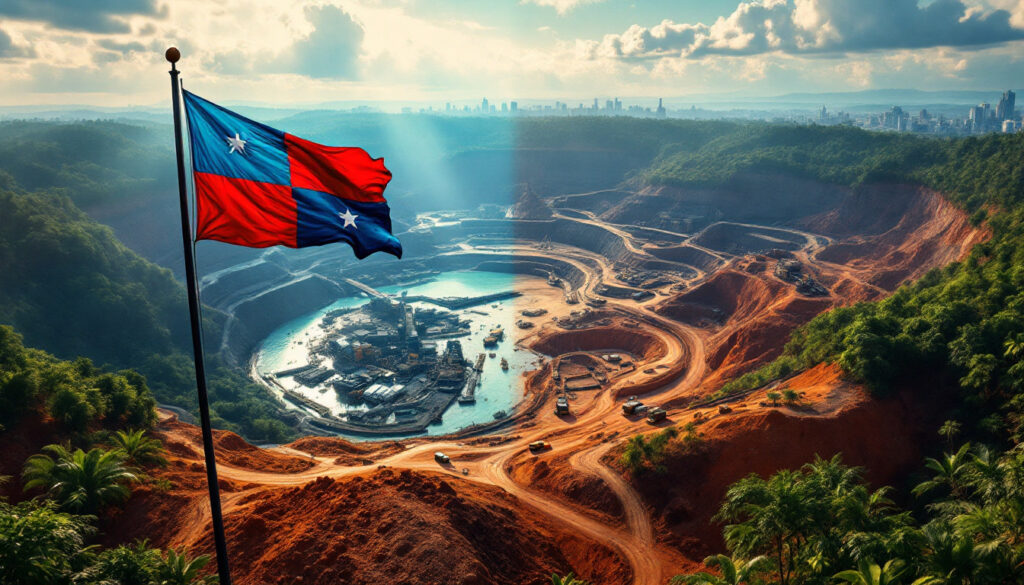What Happened to First Quantum's Mining Contract in Panama?
In a dramatic shift in Panama's resource policy, President José Raúl Molino decisively rejected First Quantum Minerals' mining contract renewal, declaring firmly: "There will be no mining law contract, period." This unequivocal statement marked the beginning of a significant economic and political standoff between the Central American nation and one of the world's largest copper producers.
The $10 billion Cobre Panama copper mine, First Quantum's flagship project in the country, has been completely shut down since November 2023. This massive operation wasn't just any mining contract in Panama – it represented approximately 5% of Panama's entire GDP before its closure, making it a cornerstone of the national economy.
The shutdown came after months of escalating tensions between the government and the Canadian mining giant, culminating in the Supreme Court of Panama ruling the company's mining concession unconstitutional. This legal decision provided the foundation for President Molino's subsequent rejection of any new contract arrangement.
The Current Status of Cobre Panama Copper Mine
The Cobre Panama mine now sits idle despite representing a $10 billion investment by First Quantum Minerals. This state-of-the-art facility, which was once Panama's largest private investment, has been placed under what the company calls "preservation and safe maintenance" mode.
Prior to its closure, the mine employed approximately 8,000 workers directly and supported an estimated 20,000 additional indirect jobs throughout Panama's economy. These positions ranged from skilled mining engineers to transportation workers and service providers in local communities.
The shutdown has created a significant void in Panama's export profile, as copper from Cobre Panama accounted for approximately 16% of the country's total exports in 2022. This sudden removal of such a substantial economic contributor has sent ripples through Panama's entire economic system, forcing government officials to revise growth projections dramatically downward.
Why Did Panama Cancel First Quantum's Mining Contract?
The contract cancellation stems from complex factors that intersect politics, economics, and national identity in Panama. Understanding these motivations provides critical context for evaluating potential resolution paths.
National Sovereignty Concerns
At the heart of Panama's decision lies a fundamental question of resource ownership. President Molino emphatically stated that "the mine belongs to Panama and its people," reflecting a growing sentiment across Latin America regarding foreign control of natural resources.
This position connects to Panama's constitutional provisions, specifically Article 257, which explicitly grants state ownership of all mineral resources within the country's borders. The Supreme Court of Panama cited this constitutional principle when invalidating First Quantum's original concession.
Panama's approach reflects a broader regional shift toward resource nationalism, where governments are increasingly asserting greater control over extractive industries. This trend has gained momentum across Latin America, with countries like Chile, Peru, and Mexico all implementing similar policies in recent years.
The decision also came amid growing public pressure, with some of Panama's largest protests in recent history occurring in late 2023. Over 50,000 Panamanians participated in demonstrations against the mining contract, viewing it as an infringement on national sovereignty and an unfair arrangement that primarily benefited foreign interests.
Economic and Environmental Considerations
Despite the significant economic contribution of the mine, Panama's government prioritized other factors in its decision-making process. The administration faced mounting criticism that the previous contract terms were overly favorable to First Quantum, with allegations that tax and royalty structures failed to deliver fair compensation for Panama's copper resources.
Environmental concerns also played a crucial role in the government's decision. Local environmental agencies documented impacts on surrounding ecosystems, with estimates suggesting up to 12% biodiversity loss in areas adjacent to mining operations. The mine's location near the Mesoamerican Biological Corridor raised particular concerns about potential long-term ecological damage.
Public sentiment had shifted dramatically against foreign control of natural resources, with a 2023 survey by the University of Panama indicating that 68% of citizens believed natural resources should be exclusively managed by Panamanian entities. This public opinion exerted significant pressure on the government to take decisive action.
What Options Remain for First Quantum Minerals in Panama?
Despite the definitive rejection of a traditional mining contract, pathways for continued operations might still exist through alternative arrangements.
Potential Partnership Opportunities
While rejecting a conventional mining contract, President Molino notably "kept the door open for a partnership" arrangement. This distinction between contract law and partnership frameworks could provide the basis for future negotiations.
The mining sector across Latin America has been evolving toward more collaborative models, with approximately 60% of major mining projects now structured as joint ventures rather than traditional concessions. This trend reflects both government preferences for greater control and companies' adaptation to changing political dynamics in commodities.
Potential structures could include a joint venture where Panama's government holds a majority stake, similar to the partnership between Chile's state-owned Codelco and Rio Tinto established in 2022. Under that arrangement, the Chilean government maintains 51% ownership while still benefiting from private sector expertise and capital.
Another option could involve a profit-sharing agreement where First Quantum continues to operate the mine but under a revised financial structure that guarantees a higher percentage of revenues flowing to Panama's treasury. This approach has been implemented successfully in Peru and Ecuador in recent years.
Requirements for Any Future Agreement
For any future arrangement to succeed, it must explicitly acknowledge Panamanian ownership of the mine and its resources. This recognition goes beyond mere legal formality – it represents a fundamental principle from which the government appears unwilling to deviate.
The structure would need to shift from a traditional mining concession to a cooperative framework that positions First Quantum more as a technical partner or service provider rather than a resource owner. This distinction, while seemingly semantic, carries significant legal and political implications in Panama.
Financial terms would also require substantial revision, with industry analysts suggesting royalty rates would need to at least double from previous levels to satisfy government demands. Additionally, greater transparency regarding environmental practices and community investments would likely be non-negotiable elements.
How Does This Dispute Impact Panama's Economy?
The closure of Cobre Panama has triggered multifaceted economic consequences that extend far beyond the mining sector itself.
Economic Consequences of the Mine Closure
The immediate economic impact has been severe, with Panama's GDP growth projections revised downward significantly. The International Monetary Fund adjusted its 2024 growth forecast for Panama from 4.7% to just 2.1% directly citing the mine closure as the primary factor.
Unemployment figures reflect the human cost of the shutdown, with 8,000 direct jobs eliminated and an estimated 20,000 indirect positions affected. This represents approximately 1.3% of Panama's total workforce suddenly displaced, creating significant pressure on social services and other employment sectors.
Export revenues have declined sharply, with Panama's Central Bank reporting a 22% drop in total exports during the first quarter of 2024 compared to the same period in 2023. This reduction has contributed to a widening trade deficit and placed pressure on Panama's currency stability.
Tax revenue losses are equally significant, with government estimates suggesting approximately $375 million in annual tax receipts vanished with the mine's closure. This fiscal gap has complicated budget planning and potentially threatens public investment programs.
Broader Investment Climate Implications
Beyond immediate economic impacts, the dispute has raised questions about Panama's investment climate and regulatory predictability. Foreign direct investment in Panama's mining sector plummeted by 78% year-over-year according to the Central Bank's latest figures.
International credit rating agencies have expressed concern, with Moody's placing Panama's investment grade rating on "negative watch" specifically citing concerns about policy predictability and contract enforcement. This status could potentially increase borrowing costs for both the government and private enterprises.
The dispute has created ripple effects in other sectors considering major investments in Panama, particularly infrastructure and energy projects where long-term contracts similar to mining concessions are standard. Several planned projects have reportedly been placed under review pending resolution of the First Quantum situation.
However, some analysts argue the government's stance may ultimately strengthen investment quality by establishing clearer expectations regarding resource governance. Dr. Carlos Vargas from the University of Panama notes: "GDP reliance on foreign extraction undermines long-term stability. A more balanced approach could attract more sustainable investment models."
What's Next for Copper Mining in Panama?
The path forward remains uncertain, with multiple scenarios possible depending on both government positions and First Quantum's strategic decisions.
Possible Resolution Scenarios
The most likely scenario involves negotiations toward a restructured partnership where Panama's government maintains clear ownership while First Quantum provides technical expertise and capital. Industry analysts suggest such talks could begin in earnest by late 2024, potentially leading to a revised agreement by mid-2025.
If partnership negotiations fail, Panama might seek alternative operating partners. Several major mining companies from both Latin America and Asia have reportedly expressed preliminary interest in the project should First Quantum exit completely.
A third possibility involves Panama developing the capacity to operate the mine through a newly established state enterprise. While this would require significant mining feasibility insights and technical expertise development, countries like Chile and Bolivia have successfully implemented similar models in their mining sectors.
The timeline for any resolution remains highly uncertain. Mining analysts estimate that even with a swift agreement, the mine would require 6-9 months of preparation before operations could resume due to maintenance needs and workforce reassembly requirements.
Global Copper Market Implications
Cobre Panama represented approximately 1.5% of global copper production before its shutdown, a significant enough portion to impact worldwide supply dynamics. Goldman Sachs analysts note this closure has contributed to tightening copper supplies globally.
The timing of this supply disruption is particularly significant given projected copper demand increases. The International Energy Agency forecasts a 40% rise in global copper market trends by 2030, driven primarily by renewable energy technologies and electric vehicle production.
Copper prices have shown sensitivity to developments in the Panama situation, with price fluctuations of 3-5% following major announcements regarding the dispute. This volatility underscores the mine's importance to global markets despite representing a relatively small percentage of total production.
The strategic importance of copper for technology and energy transition makes this dispute relevant beyond Panama's borders. As countries worldwide pursue decarbonization goals, secure copper supplies have become increasingly vital to national economic strategies, creating challenging copper production dynamics across major producing regions.
FAQ About Panama's Mining Contract Dispute
What was the economic importance of Cobre Panama mine?
The Cobre Panama copper mine represented approximately 5% of Panama's entire GDP before its closure in 2023. It employed 8,000 workers directly and supported an estimated 20,000 indirect jobs throughout the economy. Additionally, copper exports from the mine accounted for roughly 16% of Panama's total export revenue, making it a critical component of the country's economic structure.
Is there any chance the mine will reopen?
While President Molino ruled out a new mining contract law, he specifically kept the door open for a partnership arrangement. This distinction suggests opportunities exist for resumed operations under different structural terms. Industry experts estimate a 60-70% probability of eventual resumption under a revised agreement, though the timeline remains uncertain. Any new arrangement would require acknowledging Panamanian ownership of the resources, as confirmed by Panama's Supreme Court.
What is First Quantum Minerals' investment in Panama?
First Quantum Minerals invested approximately $10 billion in the Cobre Panama copper mine, making it one of the largest foreign investments in Panama's history. This investment included developing the mine site, constructing processing facilities, building transportation infrastructure, and establishing power generation capabilities. The project took nearly a decade to develop before reaching full production capacity in 2022, only to face shutdown in 2023. For those interested in similar opportunities elsewhere, a comprehensive mining stocks investment guide can help navigate the complexities of resource investments in volatile political environments like First Quantum's operations in Panama.
Looking to Invest in the Next Major Mineral Discovery?
Gain a market-leading edge with Discovery Alert's proprietary Discovery IQ model that delivers real-time notifications on significant ASX mineral discoveries, turning complex data into actionable investment opportunities. Explore why major discoveries can generate substantial returns by visiting Discovery Alert's dedicated discoveries page and begin your 30-day free trial today.




